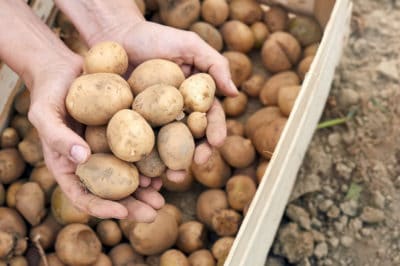Growth Stages
Each growth stage of the potato lasts for a certain length of time before the next. These stages may vary according to variety and expected maturity rates:
- Sprouting – 21 to 45 days
- Vegetative growth – four to six weeks.
- Tuber development – two weeks.
- Tuber Bulking – up to three months.
- Maturation – three or four weeks.
The Sprout
Potatoes grow from sprouts that develop from eyes in the potato itself. Not all eyes develop sprouts and some put up multiple sprouts from a single eye. The flesh of the potato supplies the required nutrients and moisture. Most gardeners chit, or sprout, their potatoes before planting. However, chitting is not required and potatoes will grow well if planted before they sprout.
Vegetative Growth
Once the plant has sprouted, stems, leaves and roots begin to develop. The visible portion of the plant – stems and leaves – make significant growth and the leaves begin the process of photosynthesis, supplying nourishment. Vegetative growth occurs when temperatures reach 60 to 70°F (16 to 21°C). Most potatoes will grow better when the days are relatively long – at least 10 and preferably 12 hours or more of sunlight.
Tuber Development
Once the plant has reached sufficient size, tubers begin to form at the tips of the underground stems, or stolons. The mass of a potato plant lies mostly 18 to 24 inches below the surface, so the gardeners won’t see this stage. However, flowering and tuber develop tend to happen at about the same time, so flower development is also a signal of tuber development.
Bulking
When tubers first develop, they may be about the size of peanuts. Bulking occurs as the tubers build up carbohydrates, water and fiber. Flowers may also develop and some potato varieties will set seed in small round fruits. About three weeks after flowering, the tubers are large enough to harvest a few new potatoes. These are delicate and don’t store well; eat immediately.
Maturity
Although the potatoes themselves continue to bulk up underground, the plant tops begin to die down as photosynthesis slows down. Many gardeners cut down the wilting plants about three or four weeks after flowering and withhold water. This forces the tubers to mature and develop tougher skins that promote long storage. Most potatoes are ready to harvest about four to six weeks after the tops die.
